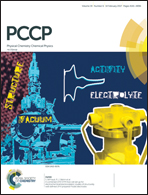Titanium oxide morphology controls charge collection efficiency in quantum dot solar cells†
Abstract
Charge transfer at the TiO2/quantum dots (QDs) interface, charge collection at the TiO2/QDs/current collector (FTO or SnO2:F) interface, and back electron transfer at the TiO2/QDs/S2− interface are processes controlled by the electron transport layer or TiO2. These key processes control the power conversion efficiencies (PCEs) of quantum dot solar cells (QDSCs). Here, four TiO2 morphologies, porous nanoparticles (PNPs), nanowires (NWs), nanosheets (NSHs) and nanoparticles (NPs), were sensitized with CdS and the photovoltaic performances were compared. The marked differences in the cell parameters on going from one morphology to the other have been explained by correlating the shape, structure and the above-described interfacial properties of a given TiO2 morphology to the said parameters. The average magnitudes of PCEs follow the order: NWs (5.96%) > NPs (4.95%) > PNPs (4.85%) > NSHs (2.5%), with the champion cell based on NWs exhibiting a PCE of 6.29%. For NWs, an optimal balance between the fast photo-excited electron injection to NWs at the NW/CdS interface, the high resistance offered at the TiO2 NW/CdS/S2− interfaces to electron recombination with the oxidized electrolyte or with the holes in CdS, the low electron transport resistance in NWs, and low dark currents, yields the highest efficiency due to directional unhindered transport of electrons afforded by the NWs. For NSHs, electron trapping in the two dimensional sheets, and a high electron recombination rate prevent the effective transfer of electrons to FTO, thus reducing short circuit current density significantly, resulting in a poor performance. This study provides a deep understanding of charge transfer, transport and collection processes necessary for the design of efficient QDSCs.



 Please wait while we load your content...
Please wait while we load your content...